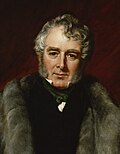This article needs additional citations for verification .(November 2021) |
| |||||||||||||||||||||||||||||||||||||||||||||||||||||
All 658 seats in the House of Commons 330 seats needed for a majority | |||||||||||||||||||||||||||||||||||||||||||||||||||||
|---|---|---|---|---|---|---|---|---|---|---|---|---|---|---|---|---|---|---|---|---|---|---|---|---|---|---|---|---|---|---|---|---|---|---|---|---|---|---|---|---|---|---|---|---|---|---|---|---|---|---|---|---|---|
| Turnout | 63.5% [1] 593,445 | ||||||||||||||||||||||||||||||||||||||||||||||||||||
| |||||||||||||||||||||||||||||||||||||||||||||||||||||
 Colours denote the winning party | |||||||||||||||||||||||||||||||||||||||||||||||||||||
 Composition of the Commons after the election | |||||||||||||||||||||||||||||||||||||||||||||||||||||
| |||||||||||||||||||||||||||||||||||||||||||||||||||||
The 1841 United Kingdom general election was held between 29 June and 22 July 1841. Following increasing government defeats, the Conservatives under Sir Robert Peel won a decisive victory against the governing Whigs. [2]
Contents
- Results
- Voting summary
- Seats summary
- Regional results
- Notable Whig MPs who lost their seats
- Notes
- References
- Further reading
- External links
The Conservatives campaigned mainly on an 11-point programme modified from their previous electoral effort and designed by Peel, whilst the Whigs emphasised reforming the import duties on corn, replacing the existing sliding scale with a uniform rate. The Whig position lost them support amongst protectionists, and the Whigs saw heavy losses in constituencies like the West Riding, where aristocratic Whig families who held a strong tradition of unbroken representation in Parliament were rejected by the electorate.
O'Connell, who had been governing with the Whigs through a compact, felt the government's unpopularity rub off on him. His own party was shattered in the election. Barely a dozen Repealers retained their seats, and O'Connell himself lost in Dublin while his son was defeated in Carlow. [3] The Chartists picked up only a few votes.



